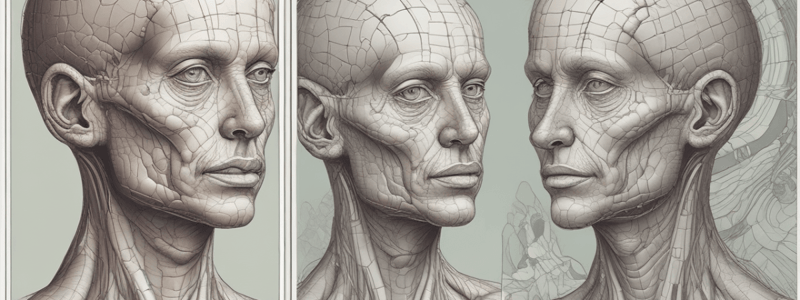Podcast
Questions and Answers
What is the function of myoepithelial cells in eccrine sweat glands?
What is the function of myoepithelial cells in eccrine sweat glands?
- To produce sweat
- To contract and move watery secretion into the duct (correct)
- To absorb ions from the water
- To release a mixture of glycoproteins and bactericidal activity
Where are apocrine sweat glands confined to?
Where are apocrine sweat glands confined to?
- The penis and areas with no hairs
- The skin of the axillary and perineal regions (correct)
- The foot soles
- All over the body, except for the thick skin
What is the function of sebaceous glands?
What is the function of sebaceous glands?
- To produce sweat
- To release a mixture of glycoproteins and bactericidal activity
- To eliminate nitrogenous waste and excess salts
- To maintain the stratum corneum and hair shafts (correct)
What type of secretion do sebaceous glands undergo?
What type of secretion do sebaceous glands undergo?
What is the function of clear cells in eccrine sweat glands?
What is the function of clear cells in eccrine sweat glands?
What is the function of dark cells in eccrine sweat glands?
What is the function of dark cells in eccrine sweat glands?
Where do sebaceous glands open directly onto the skin?
Where do sebaceous glands open directly onto the skin?
What is the composition of sebum?
What is the composition of sebum?
What is the function of eccrine sweat glands as auxiliary organs?
What is the function of eccrine sweat glands as auxiliary organs?
How do sebaceous glands develop?
How do sebaceous glands develop?
What type of glands are eccrine glands compared to apocrine glands?
What type of glands are eccrine glands compared to apocrine glands?
What type of cells do apocrine glands consist of?
What type of cells do apocrine glands consist of?
Where do apocrine glands open into?
Where do apocrine glands open into?
What type of glands produce pheromones?
What type of glands produce pheromones?
What type of nerve endings innervate apocrine glands?
What type of nerve endings innervate apocrine glands?
What type of glands are mammary glands?
What type of glands are mammary glands?
How many lobes do mammary glands typically consist of?
How many lobes do mammary glands typically consist of?
What type of tissue separates the lobules from each other in mammary glands?
What type of tissue separates the lobules from each other in mammary glands?
What happens to the breast during pregnancy?
What happens to the breast during pregnancy?
What type of cells line the alveoli of lactating glands?
What type of cells line the alveoli of lactating glands?
Flashcards are hidden until you start studying
Study Notes
Sebaceous Glands
- Found all over the body, except for the thick skin
- Branched structure with multiple small sacs called acini, which join together into a short duct and open into a hair follicle
- Form a pilosebaceous unit with a hair follicle
- In areas with no hairs (e.g., penis), the sebaceous gland opens directly onto the skin
- Produce sebum, a complex mixture of lipids, through holocrine secretion
- Sebum helps maintain the stratum corneum and hair shafts, and has weak antibacterial and antifungal properties
Sweat Glands
- Develop as long epidermal invaginations embedded in the dermis
- Two types: eccrine and apocrine sweat glands
- Eccrine sweat glands:
- Most numerous on the foot soles
- Coiled and small lumen of both secretory components and ducts
- Secretory part consists of stratified cuboidal epithelium with three types of cells (dark, clear, and myoepithelial cells)
- Produce sweat through merocrine secretion
- Ducts absorb ions from the water to prevent excessive electrolyte loss
- Function as auxiliary excretory organs, eliminating small amounts of nitrogenous waste and excess salts
- Apocrine sweat glands:
- Confined to the skin of axillary and perineal regions
- Development depends on sex hormones
- Have much larger lumens than eccrine glands
- Produce pheromones
- Innervated by adrenergic nerve endings
Mammary Glands
- Compound tubuloalveolar glands
- Consist of 15-25 lobes
- Stroma and parenchyma:
- Stroma: adipose tissue, dense CT separating the lobules from each other
- Parenchyma: consists of lactiferous ducts and alveoli
- Before puberty: lactiferous sinuses and lactiferous ducts
- During puberty: high estrogen levels lead to accumulation of adipose CT and increase of lactiferous ducts
- Each lobule consists of several ducts that empty into one terminal duct
- Lactiferous ducts are lined by simple cuboidal epithelium covered by myoepithelial cells
- During pregnancy, the breast undergo enlargement due to hormones
- After pregnancy, prolactin secretion leads to milk production
- Alveoli of lactating glands are lined by cuboidal epithelium with myoepithelial cells
- Secretory cells contain lipid droplets containing caseins (milk proteins) and lactose
Studying That Suits You
Use AI to generate personalized quizzes and flashcards to suit your learning preferences.




